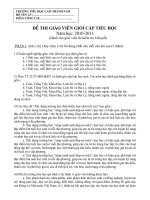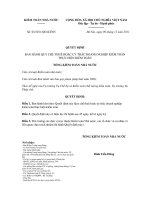Astm c 1194 03 (2011)
Bạn đang xem bản rút gọn của tài liệu. Xem và tải ngay bản đầy đủ của tài liệu tại đây (76.43 KB, 2 trang )
Designation: C1194 − 03 (Reapproved 2011)
Standard Test Method for
Compressive Strength of Architectural Cast Stone1
This standard is issued under the fixed designation C1194; the number immediately following the designation indicates the year of
original adoption or, in the case of revision, the year of last revision. A number in parentheses indicates the year of last reapproval. A
superscript epsilon (´) indicates an editorial change since the last revision or reapproval.
1. Scope
5. Apparatus
1.1 This test method covers the sampling, preparation of
specimens, and determination of the compressive strength of
architectural cast stone.
5.1 Testing Machine—The testing machine shall conform to
the requirements prescribed in Test Method C109/C109M
unless otherwise indicated therein.
1.2 The values stated in inch-pound units are to be regarded
as standard. The values given in parentheses are mathematical
conversions to SI units that are provided for information only
and are not considered standard.
1.3 This standard does not purport to address all of the
safety concerns, if any, associated with its use. It is the
responsibility of the user of this standard to establish appropriate safety and health practices and determine the applicability of regulatory limitations prior to use.
6. Sampling
6.1 Select the sample to represent the cast stone under
consideration. The sample may be selected by the purchaser or
his authorized representative from each 500 ft3 (14 m3) of cast
stone. Select a sample of adequate size to permit the preparation of three compression test specimens.
7. Test Specimens
7.1 For compression tests, take three specimens from each
sample. Cut specimens from the finished surface of the sample
to consist of one surface intended to be exposed to view and
five saw-cut surfaces, except for faced cast stone, cut specimens through the faced surface to consist of approximately
equal parts of the facing material and the backup material.
2. Referenced Documents
2.1 ASTM Standards:2
C42/C42M Test Method for Obtaining and Testing Drilled
Cores and Sawed Beams of Concrete
C109/C109M Test Method for Compressive Strength of
Hydraulic Cement Mortars (Using 2-in. or [50-mm] Cube
Specimens)
C617 Practice for Capping Cylindrical Concrete Specimens
7.2 Cut test specimens from the sample with saws. The test
specimens shall be 2-in. (50.8-mm) or 50-mm cubes. The
allowable size tolerance of the cubes shall be 61⁄8 in. (3.2 mm).
3. Terminology
7.3 Measure the top and bottom of the bearing surfaces of
the test specimens to 0.01 in. (0.25 mm) and average the two
bearing areas to obtain the compression area.
3.1 Definitions:
3.1.1 cast stone, n—an architectural precast concrete building unit intended to simulate natural cut stone.
8. Conditioning
4. Significance and Use
8.1 For this test, oven dry specimens at a temperature of 100
to 110°C (212 to 230°F) until the loss in mass is not more than
0.1 % in 24 h of drying. Remove from the oven and allow to
cool in room temperature for 4 to 6 h before capping.
4.1 This test method is to be used in determining the
compressive strength of cast stone. Compressive strength is
one measure of resistance of cast stone to weathering and
structural stress.
9. Specimen Preparation
9.1 Cap each specimen, after drying, using equipment,
materials, and procedures that conform to those specified in
Practice C617. Capping material is required that will exceed
the compressive strength of the tested cubes. Form the cap by
spreading the capping material upon a capping plate and
pressing the specimen firmly on it. Make the cap as thin as
possible but not to exceed 3⁄32 in. (2.4 mm). Caps must be
allowed to harden a minimum of 16 hours prior to testing.
1
This test method is under the jurisdiction of ASTM Committee C27 on Precast
Concrete Products and is the direct responsibility of Subcommittee C27.20 on
Architectural and Structural Products.
Current edition approved May 1, 2011. Published June 2011. Originally
published in 1991. Last previous edition approved in 2003 as C1194 – 03. DOI:
10.1520/C1194-03R11.
2
For referenced ASTM standards, visit the ASTM website, www.astm.org, or
contact ASTM Customer Service at For Annual Book of ASTM
Standards volume information, refer to the standard’s Document Summary page on
the ASTM website.
Copyright © ASTM International, 100 Barr Harbor Drive, PO Box C700, West Conshohocken, PA 19428-2959. United States
1
C1194 − 03 (2011)
10. Procedure
11. Calculations
10.1 Apply load through a spherical bearing block placed on
top of the specimen in a vertical testing machine. The loading
of homogenous specimens shall be parallel to the casting
direction and of faced specimens shall be normal to the
position in which the cast stone is laid in the wall (Fig. 1). The
area of the bearing block shall be the same, or slightly larger,
than that of the test specimen.
11.1 Calculate the compressive strength of each specimen as
follows:
C 5 W/A
(1)
where:
C = compressive strength of the specimen, psi (MPa),
W = maximum load, lbf (N), on the specimen at failure, and
10.2 Center the specimen in the testing machine and apply
the initial load at a rate which will permit hand adjustment of
the contact plate on the specimen.
A
= calculated area of the uncapped bearing surface in in.2
(mm2).
12. Report
10.3 Apply load uniformly and without shock. Loading
shall be at a rate of 200 to 350 psi/s (1380 to 2415 kPa/s) or for
testing machines of screw type, the moving head shall travel at
a rate of approximately 0.05 in./min (1.3 mm/min) when the
machine is running idle.
12.1 Report the following information.
12.1.1 The average compressive strength of three specimens
taken from a single sample with the psi results rounded off to
the nearest 10 psi.
12.1.2 The following information shall be reported as applicable: identification of the sample, mixture proportions,
compressive strength, name of the project, date of casting, and
age of sample when tested.
10.4 The compression testing machine shall have a lowrange dial or a digital reading scale that shall have an accuracy
of 61.0 % of the maximum load applied to the cast stone
specimens.
10.5 Load specimens to failure.
13. Precision and Bias
13.1 Precision—The precision of this test is similar to Test
Method C42/C42M for which data are not yet available. The
precision of this test method will be stated when data become
available.
13.2 Bias—Since there is no accepted reference material
suitable for determining the bias of results of this test method,
no statement on bias is being made.
14. Keywords
14.1 cast stone; compressive strength
FIG. 1 Loading Position
ASTM International takes no position respecting the validity of any patent rights asserted in connection with any item mentioned
in this standard. Users of this standard are expressly advised that determination of the validity of any such patent rights, and the risk
of infringement of such rights, are entirely their own responsibility.
This standard is subject to revision at any time by the responsible technical committee and must be reviewed every five years and
if not revised, either reapproved or withdrawn. Your comments are invited either for revision of this standard or for additional standards
and should be addressed to ASTM International Headquarters. Your comments will receive careful consideration at a meeting of the
responsible technical committee, which you may attend. If you feel that your comments have not received a fair hearing you should
make your views known to the ASTM Committee on Standards, at the address shown below.
This standard is copyrighted by ASTM International, 100 Barr Harbor Drive, PO Box C700, West Conshohocken, PA 19428-2959,
United States. Individual reprints (single or multiple copies) of this standard may be obtained by contacting ASTM at the above
address or at 610-832-9585 (phone), 610-832-9555 (fax), or (e-mail); or through the ASTM website
(www.astm.org). Permission rights to photocopy the standard may also be secured from the Copyright Clearance Center, 222
Rosewood Drive, Danvers, MA 01923, Tel: (978) 646-2600; />
2









